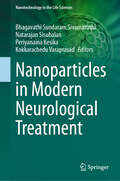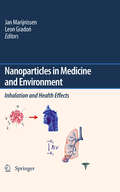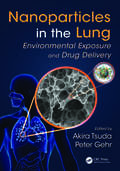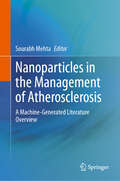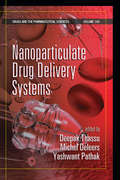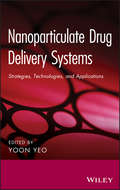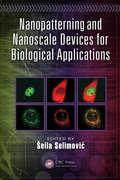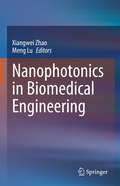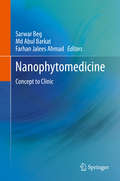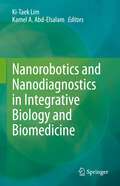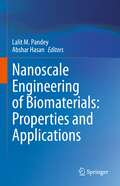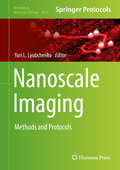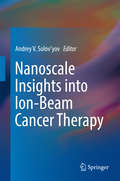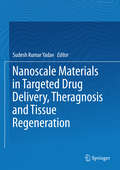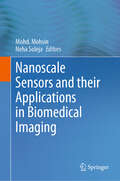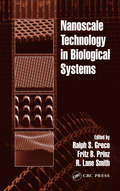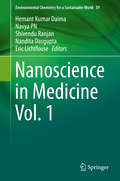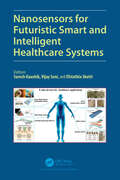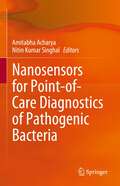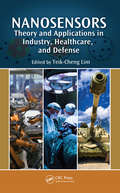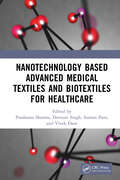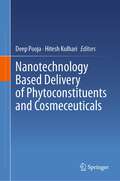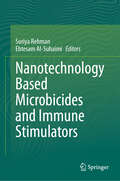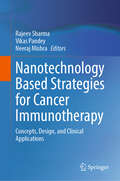- Table View
- List View
Nanoparticles in Modern Neurological Treatment (Nanotechnology in the Life Sciences)
by Bhagavathi Sundaram Sivamaruthi Natarajan Sisubalan Periyanaina Kesika Kokkarachedu Varaprasad“Nanoparticles in Modern Neurological Treatment" provides a comprehensive exploration of the promising field of nanoparticles and their applications in neurology. The book begins with an introduction, laying the foundation by elucidating the properties and applications of nanoparticles in neurological therapies and diagnostics. The introduction provides an overview of nanoparticles, their properties, and their applications in neurological disorders, discussing the rationale behind using nanoparticles in neurological therapies and diagnostics. Subsequent chapters delve into specific areas of nanoparticle utilization, exploring how nanoparticles are utilized to overcome the blood-brain barrier and effectively deliver therapeutics to the brain for treating various neurological disorders. Nanoparticle-based imaging techniques for diagnosis and monitoring of neurological disorders are examined, along with targeted therapies for neurodegenerative diseases and brain tumors. Additionally, the modulation of inflammation and neuroprotection facilitated by nanoparticles, particularly relevant in conditions like multiple sclerosis and stroke, is discussed. The potential of nanoparticles as biomarkers for diagnosing and tracking neurological disorders is also investigated. Advanced applications include neuroregeneration and repair facilitated by nanoparticles and the emerging field of theranostics combining therapy and diagnosis using nanoparticles in neurological disorders. Lastly, the promising realm of nanoparticle-mediated gene therapy is explored for precision treatment of neurological conditions. By consolidating current knowledge and exploring future potentials, this book seeks to contribute to advancements in neurology, ultimately improving patient outcomes and quality of life.
Nanoparticles in medicine and environment
by Leon Gradon J. C. MarijnissenA huge effort is put into the science of nanoparticles and their production. In many cases it is unavoidable that nanoparticles are released into the environment, either during the production processes or during the use of a product made from these particles. It is also realized that combustion processes like traffic and power plants release nanoparticles into the atmosphere. However it is not known how nanoparticles interact with the human body, especially upon inhalation. At the same time research activities are devoted to understand how nano-sized medicine particles can be used to administer medicines via inhalation. In any case it is absolutely necessary to know how the nanoparticles interfere with the inhalation system, how they deposit and affect on the human system. Three main themes are discussed: Nanoparticle sources and production Nanoparticle inhalation and deposition Toxicological and medical consequences of nanoparticles Each theme is covered comprehensively, starting at nano-quantum effects up to technical and medical applications such as measuring equipment and inhalation instrumentation. This book brings together all sub-disciplines in the field related to aerosol nanoparticles. Each chapter is written by a world expert, giving the state of the art information and challenging open questions. The last chapter summarizes in an interdisciplinary way what is already known and what still is ahead of us.
Nanoparticles in the Lung: Environmental Exposure and Drug Delivery
by Peter Gehr Akira TsudaNanoparticles have a physical dimension comparable to the size of molecular structures on the cell surface. Therefore, nanoparticles, compared to larger (e.g., micrometer) particles, are considered to behave differently when they interact with cells. Nanoparticles in the Lung: Environmental Exposure and Drug Delivery provides a better understanding
Nanoparticles in the Management of Atherosclerosis: A Machine-Generated Literature Overview
by Sourabh MehtaThe book's primary objective is to introduce the pathology and physiology atherosclerosis in brief, and its diagnosis and treatment. Atherosclerosis is an inflammatory disease of the arterial wall. An advanced understanding of atherosclerosis shows that it leads to myocardial infarction and other cardiovascular diseases, taking 17 million people every year worldwide. The literature suggests that atherosclerosis is an ancient disease and is still a long-standing health problem globally. Hence early diagnosis and treatment of atherosclerosis are crucial to solving long-standing health issues.This book provides a systemic summary of recent literature focusing on disease pathology, advancement in diagnosis and therapies. Recently, nanoparticles performing dual roles as diagnostic and therapeutic agents have been keenly interested. However, the nanoparticle has yet to reach the clinic. Understanding the role of biomaterials in formulations and existing strategies is critical whendeveloping novel formulations and working on translation to clinical settings. The book provides a systematic biomaterial-based summary of the literature, methods used to formulate nanoparticles, and their scale-up potential. Another key objective of the book is to motivate the reader to conduct research on theranostic nanoparticles to treat atherosclerosis and put us one step closer to solving a long-standing health problem—atherosclerosis.The auto-summaries have been generated by a recursive clustering algorithm via the Dimensions Auto-summarizer by Digital Science handled by Subject Matter Experts and the external editor. The editor of this book selected which SN content should be auto-summarized and decided its order of appearance. Please be aware that the auto-summaries consist of original sentences, but are not representative of its original paper, since we do not show the full length of the publication. Please note that only published SN content is represented here, and that machine-generated books are still at an experimental stage.
Nanoparticulate Drug Delivery Systems: Barriers And Application Of Nanoparticulate Systems (Drugs And The Pharmaceutical Sciences Ser. #Vol. 166)
by Yashwant Vishnupant Pathak Deepak Thassu Michel DeleersWith the advent of analytical techniques and capabilities to measure particle sizes in nanometer ranges, there has been tremendous interest in the use of nanoparticles for more efficient methods of drug delivery. Nanoparticulate Drug Delivery Systems addresses the scientific methodologies, formulation, processing, applications, recent trends, and e
Nanoparticulate Drug Delivery Systems: Strategies, Technologies, and Applications
by Yoon YeoFrank discussions of opportunities and challenges point the way to new, more effective drug delivery systems Interest in nanomedicine has grown tremendously, fueled by the expectation that continued research will lead to the safe, efficient, and cost-effective delivery of drugs or imaging agents to human tissues and organs. The field, however, has faced several challenges attempting to translate novel ideas into clinical benefits. With contributions from an international team of leading nanomedicine researchers, this book provides a practical assessment of the possibilities and the challenges of modern nanomedicine that will enable the development of clinically effective nanoparticulate drug delivery products and systems. Nanoparticulate Drug Delivery Systems focuses on the rationales and preclinical evaluation of new nanoparticulate drug carriers that have yet to be thoroughly reviewed in the literature. The first chapter sets the stage with a general overview of targeted nanomedicine. The book then explores new and promising nanoparticulate drug delivery systems, including: Lipid nanoparticles for the delivery of nucleic acids Multifunctional dendritic nanocarriers Polymer drug nanoconjugates Next, the book presents new opportunities and challenges for nanoparticulate drug delivery systems, including: Clearance of nanoparticles during circulation Drug delivery strategies for combatting multiple drug resistance Toxicological assessment of nanomedicine Chapters offer state-of-the-technology reviews with extensive references to facilitate further investigation. Moreover, each chapter concludes with an expert assessment of remaining challenges, pointing the way to solutions and new avenues of research. With its frank discussions of opportunities and challenges, Nanoparticulate Drug Delivery Systems sets a solid foundation for new research leading to the discovery and development of better nanomedicines.
Nanopatterning and Nanoscale Devices for Biological Applications (Devices, Circuits, and Systems)
by Krzysztof Iniewski Šeila SelimovićNanoscale techniques and devices have had an explosive influence on research in life sciences and bioengineering. Reflecting this influence, Nanopatterning and Nanoscale Devices for Biological Applications provides valuable insight into the latest developments in nanoscale technologies for the study of biological systems. Written and edited by experts in the field, this first-of-its-kind collection of topics: Covers device fabrication methods targeting the substrate on the nanoscale through surface modification Explores the generation of nanostructured biointerfaces and bioelectronics elements Examines microfluidically generated droplets as reactors enabling nanoscale sample preparation and analysis Gives an overview of key biosensors and integrated devices with nanoscale functionalities Discusses the biological applications of nanoscale devices, including a review of nanotechnology in tissue engineering Readers gain a deep understanding of the cutting-edge applications of nanotechnologies in biological engineering, and learn how to apply the relevant scientific concepts to their own research. Nanopatterning and Nanoscale Devices for Biological Applications is the definitive reference for researchers in engineering, biology, and biomedicine, and for anyone exploring the newest trends in this innovative field.
Nanophotocatalysis and Environmental Applications: Detoxification and Disinfection (Environmental Chemistry for a Sustainable World #30)
by Eric Lichtfouse Inamuddin Abdullah M. AsiriThis book will be a guiding path to understand the photocatalytic process and mechanism for the deterioration of heavy metals, persistent organic pollutants and pathogens from wastewater. Environmental remediation is of crucial importance in the context of human sustainability in the present and future times. The unplanned anthropogenic activities and revolutionary industrialization end up in environmental contamination with noxious organic-inorganic and biogenic pollutants. The photocatalytic disinfection and detoxification is the only solution to preserve and restore the ecological balance. The main emphasis is to explore and enhance the photocatalytic potentials of solar active-materials.
Nanophotonics in Biomedical Engineering
by Meng Lu Xiangwei ZhaoThis book summarizes the latest advances in nanophotonics for biomedical applications, including biomolecular sensing and imaging, additive fabrications, and biophotonics. The engineering of nanophotonics will have significant impacts on the life sciences and medicine alike. Given its scope, the book offers a valuable asset for researchers, scientists, engineers, and graduate students in the fields of biomedical engineering, electrical engineering, materials sciences, optics, biology, and medicine.
Nanophytomedicine: Concept to Clinic
by Sarwar Beg Farhan Jalees Ahmad Md Abul BarkatNanophytomedicine is a field that involves the application of nanomedicine-based systems to phytotherapy and phytopharmacology. This book assesses the clinical successes and failures of nanophytomedicine and also highlights emerging concepts in this field. The content is divided into three sections, the first of which describes core issues in the pharmaceuticals industry in connection with the successes, failures and prospects of nanophytomedicine. The second section highlights recent advances in phytomedicine formulation development based on nanotechnology approaches, while also discussing a variety of nanocarrier systems for the successful delivery of phytomedicines. Focusing on the clinical perspective, the third section addresses the current clinical status of nanophytomedicine as a single drug therapy or combinatorial drug therapy, pharmacovigilance, pharmacokinetics, drug interactions and toxicological profiles, while also providing concluding remarks on recent experimental findings, and considering ethical issues & regulatory challenges in nanophytomedicine. Given its scope, the book offers a valuable guide for early career researchers, young scientists, master level students, academics and industrial scientists working in various healthcare fields, e.g. the pharmaceutical and biological sciences, life sciences, biotechnology, biomedical engineering, and nanobiotechnology.
Nanorobotics and Nanodiagnostics in Integrative Biology and Biomedicine
by Kamel A. Abd-Elsalam Ki-Taek LimNanorobotics and Nanodiagnostics in Integrative Biology and Biomedicine "Nanorobotics and nanodiagnostics” can be defined as a new generation of biohybrid and nanorobotics that translate fundamental biological principles into engineering design rules, or integrative living components into synthetic structures to create biorobots and nanodiagnotics that perform like natural systems. Nanorobots or nanobots are structured of a nanoscale made of individual assemblies. They can be termed as intelligent systems manufactured with self-assembly strategies by chemical, physical and biological approaches. The nanorobot can determine the structure and enhance the adaptability to the environment in interdisciplinary tasks."Nanorobotics and nanodiagnostics" is a new generation of biohybrid that translates fundamental biological principles into engineering design rules to create biorobots that perform like natural systems. These biorobotics and diagnostics can now perform various missions to be accomplished certain tasks in the research areas such as integrative biology and biomedicine. "Nanorobotics and Nanodiagnostics in Integrative Biology and Biomedicine" sheds light on a comprehensive overview of the multidisciplinary areas that explore nanotherapeutics and nanorobotic manipulation in biology and medicine. It provides up-to-date knowledge of the promising fields of integrative biology and biomedicine for nano-assisted biorobotics and diagnostics to detect and treat diseases that will enable new scientific discoveries.
Nanoscale Engineering of Biomaterials: Properties and Applications
by Lalit M. Pandey Abshar HasanThis book provides a comprehensive overview of the latest advances in a wide range of biomaterials for the development of smart and advanced functional materials. It discusses the fundamentals of bio-interfacial interactions and the surface engineering of emerging biomaterials like metals and alloys, polymers, ceramics, and composites/nanocomposites. In turn, the book addresses the latest techniques and approaches to engineering material surfaces/interfaces in, e.g., implants, tissue engineering, drug delivery, antifouling, and dentistry. Lastly, it summarizes various challenges in the design and development of novel biomaterials. Given its scope, it offers a valuable source of information for students, academics, physicians and particularly researchers from diverse disciplines such as material science and engineering, polymer engineering, biotechnology, bioengineering, chemistry, chemical engineering, nanotechnology, and biomedical engineering for various commercial and scientific applications.
Nanoscale Imaging: Methods and Protocols (Methods in Molecular Biology #1814)
by Yuri L. LyubchenkoThis volume presents readers with the latest techniques to study nanoimaging and nanoprobing in application to a broad range of biological systems. The chapters in this book are divided into five parts, and cover topics such as imaging and probing of biomacromolecules including high-speed imaging and probing with AFM; probing chromatin structure with magnetic tweezers; and fluorescence correlation spectroscopy on genomic DNA in living cells. Written in the highly successful Methods in Molecular Biology series format, chapters include introductions to their respective topics, lists of the necessary materials and reagents, step-by-step, readily reproducible laboratory protocols, and tips on troubleshooting and avoiding known pitfalls.Cutting-edge and through, Nanoscale Imaging: Methods and Protocols is a valuable resource for anyone interested in learning more about this developing and expanding field.
Nanoscale Insights into Ion-Beam Cancer Therapy
by Andrey V. Solov’yovThis book provides a unique and comprehensive overview of state-of-the-art understanding of the molecular and nano-scale processes that play significant roles in ion-beam cancer therapy. It covers experimental design and methodology, and reviews the theoretical understanding of the processes involved. It offers the reader an opportunity to learn from a coherent approach about the physics, chemistry and biology relevant to ion-beam cancer therapy, a growing field of important medical application worldwide. The book describes phenomena occurring on different time and energy scales relevant to the radiation damage of biological targets and ion-beam cancer therapy from the molecular (nano) scale up to the macroscopic level. It illustrates how ion-beam therapy offers the possibility of excellent dose localization for treatment of malignant tumours, minimizing radiation damage in normal tissue whilst maximizing cell-killing within the tumour, offering a significant development in cancer therapy. The full potential of such therapy can only be realized by better understanding the physical, chemical and biological mechanisms, on a range of time and space scales that lead to cell death under ion irradiation. This book describes how, using a multiscale approach, experimental and theoretical expertise available can lead to greater insight at the nanoscopic and molecular level into radiation damage of biological targets induced by ion impact. The book is intended for advanced students and specialists in the areas of physics, chemistry, biology and medicine related to ion-beam therapy, radiation protection, biophysics, radiation nanophysics and chemistry, atomic and molecular physics, condensed matter physics, and the physics of interaction of charged particles with matter. One of the most important features of the book is the inclusive multiscale approach to the understanding of complex and highly interdisciplinary processes behind ion-beam cancer therapy, which stretches from the atomistic level up to the biological scale and is demonstrated to be in excellent agreement with experimental observations.
Nanoscale Materials in Targeted Drug Delivery, Theragnosis and Tissue Regeneration
by Sudesh Kumar YadavThis book is the first of its kind to offer a comprehensive and up-to-date discussion of the use of nanoscale materials for biomedical applications, with a particular focus on drug delivery, theragnosis and tissue regeneration. It also describes in detail the methods used in the preparation of nanoparticles. Response of nanoparticles in biological systems are also explored. Nanotechnology has led to the advent of a new field, nanomedicine, which focuses on the use of nanomaterials as drug-delivery vehicles to develop highly selective and effective drugs. The combination of molecular imaging and nanotechnology has produced theragnostic nanoparticles, which allow the simultaneous detection and monitoring of diseases. Nanotechnology can also be combined with biomaterials to create scaffolds for tissue regeneration. Further, significant advances have been made in the areas of drug delivery, theragnostic nanoparticles and tissue regeneration materials. Some nanomedicines and tissue regeneration materials are already commercially available, while others are undergoing clinical trials, and promising results have been documented. Despite the rapid advances in nanomedicine, there is a relative dearth of literature on the biomedical applications of nanoscale materials.
Nanoscale Sensors and their Applications in Biomedical Imaging
by Mohd. Mohsin Neha SolejaThe book offers a comprehensive exploration of cutting-edge nano-sensor technologies and their critical role in the field of biomedicine. This book covers a diverse range of topics, from fluorescence-based nanosensors that detect and quantify nanovesicles at the nanoscale to the recent advances in nano biosensors for agriculture and health applications. It provides valuable insights into the green synthesis of silver nanoparticles and their biomedical applications, highlighting eco-friendly approaches to nanomaterial production. The use of FRET-based tools for real-time quantification of vitamins and bioimaging is also extensively discussed, presenting innovative techniques for analysis. The book further delves into the potential of nanosensors in medicine, exploring the characteristic features that make them promising candidates for various medical applications. It also covers the application of fluorescent biosensors for intracellular signalling analysis, paving the way for understanding complex cellular processes. The book also discusses the use of nanosensors for monitoring blood clotting disorders, offering new possibilities for diagnostic and therapeutic interventions. It also presents fluorescent probes for detecting gas transmitters, such as H2S, CO, and NO, which have significant implications in the field of gas sensing and medical research. It serves as a valuable resource for researchers, scientists, and professionals in the fields of nanotechnology, biotechnology, and medicine, offering ground-breaking insights into the rapidly evolving world of nano sensors and their significant impact on healthcare and diagnostics.
Nanoscale Technology in Biological Systems
by Fritz B. Prinz Ralph S. Greco R. Lane SmithNanoscale Technology in Biological Systems reviews recent accomplishments in the field of nanobiology and introduces the application of nanoscale matrices to human biology. It focuses on the applications of nanotechnology fabrication to biomedical devices and discusses new physical methods for cell isolation and manipulation and intracellular commu
Nanoscience in Medicine Vol. 1 (Environmental Chemistry for a Sustainable World #39)
by Eric Lichtfouse Shivendu Ranjan Nandita Dasgupta Hemant Kumar Daima Navya PnThis book takes a systematic approach to address the gaps relating to nanomedicine and bring together fragmented knowledge on the advances on nanomaterials and their biomedical applicability. In particular, it demonstrates an exclusive compilation of state of the art research with a focus on fundamental concepts, current trends, limitations, and future directions of nanomedicine.
Nanosensors for Futuristic Smart and Intelligent Healthcare Systems
by Suresh Kaushik, Vijay Soni and Efstathia SkottiThe book, Nanosensors for Futuristic Smart and Intelligent Healthcare Systems, presents a treatise on nanosensors technology including wearables, implantable devices and wireless tools. The recent pandemic (COVID-19) has changed the behaviour of people towards diagnosis of infectious diseases and monitoring remote patient health status in real-time. The main focus of this book is the basic concepts of nanomaterials and sensing paradigms for medical devices based on nanosensor technology. The book will be valuable to researchers, engineers and scientists interested in the field of healthcare for monitoring health status in real-time.
Nanosensors for Point-of-Care Diagnostics of Pathogenic Bacteria
by Amitabha Acharya Nitin Kumar SinghalThis book comprehensively reviews various nanodiagnostic approaches for the detection of bacterial pathogens. The initial chapter of the book discusses receptors present on bacterial cell surfaces that can be targeted for diagnostic applications. The book then presents different fluorescent nanoparticle systems that are used for bacterial detection. Further, it covers surface plasmon resonance (SPR), ELISA, and QCM-based nanosensors to detect pathogenic bacteria. It examines different nanosensors used for the microfluidic-based detection of bacterial pathogens, including microfluidic paper-based analytical devices (μPADs), lateral flow devices, and miniaturized PCR devices. The book also covers the current electrochemical, voltammetric, and amperometric nanosensors-based microorganism recognition approaches. Lastly, the book summarizes the current challenges and the futuristic application of nanosensors to detect bacterial pathogens. This book is an invaluable resource for all medical laboratories and clinical institutions dealing with infectious diseases.
Nanosensors: Theory and Applications in Industry, Healthcare and Defense
by Teik-Cheng LimNanosensors are rapidly becoming a technology of choice across diverse fields. They offer effective and affordable options for detecting and measuring chemical and physical properties in difficult-to-reach biological and industrial systems operating at the nanoscale. However, with nanosensor development occurring in so many fields, it has become di
Nanotechnology Based Advanced Medical Textiles and Biotextiles for Healthcare
by Vivek Dave Prashansa Sharma Devsuni Singh Suman PantThis book provides systematic coverage of research into medical and biotextiles based on nanomaterials as applicable in healthcare. Divided into three sections, it explains manufacturing, properties, types, and recent developments in nanotechnology based medical textiles backed by case studies. It includes a wide range of different clinical applications of biotextiles for healthcare including nanotextile scaffolds, nano-based artificial organs, surgical sutures, enzymatic assisted enhanced biotextiles, tissue engineering or drug delivery system via nanofibers, and so forth.Features: Provides strong and broad overview of medical applications in the field of nano and biotextiles. Highlights different approaches, recent research, and emerging innovations. Covers designing or developing nanomaterials based antiviral surface disinfectants with self-cleaning property. Reviews different applications of nano based medical textiles such as deodorizing or pH control clothing for hygiene maintenance. Includes the real-life applications based descriptive case studies that offer a diverse range of perspectives. This book is aimed at researchers and graduate students in textile technology and engineering, and medical textiles.
Nanotechnology Based Delivery of Phytoconstituents and Cosmeceuticals
by Deep Pooja Hitesh KulhariThis book explores the role of nanotechnology in the delivery of natural phytoconstituents and cosmeceuticals. It presents polymeric nanocarriers, lipid-based nanocarriers, metal/metal oxide nanocarriers, protein nanocarriers, and dendrimers for the delivery of phytoconstituents. Further, it focuses on the usage of phytocompounds in various cosmeceutical products and nano delivery technologies used in the delivery of various cosmeceuticals. Finally, the book reviews the toxicity issues of nanoparticles in the delivery of phytoconstituents and cosmeceuticals and regulatory aspects for clinical applications of nano phytomedicines. This book is helpful for academicians and researchers working in pharmaceutical sciences, nano science, material science, plant science, and cosmetic science.
Nanotechnology Based Microbicides and Immune Stimulators
by Suriya Rehman Ebtesam Al-SuhaimiThis book reviews the use of nano-based drug delivery systems and biomaterials to enhance the immune system against infectious diseases. It focusses on the inbuilt immunoreactive properties of nanomaterials and the advancement in its engineering to modulate the immune system either via immune-stimulation or immunosuppression. The book further discusses the use of nanoparticle-based vaccines to improve vaccine efficacy, immunization strategies, and targeted delivery to achieve desired immune responses at the cellular level against infectious diseases. Perhaps, book focusses on nanoscale diagnostics that offer new approaches for sensitive health monitoring that are potable and can guide the use of nanoscale therapies. This book explores the potential of immunomodulatory nanotechnologies, focusing not only on their benefits, but also on biocompatibility, and toxicity concerns, while highlighting promising innovations in Interferon-based immune therapies and addressing key challenges in achieving safe, scalable nanotech products. The book would encompass broad topics to attract the diverse specialty of physicians, health professionals, students, faculty, and researchers of nanotechnology, nanomedicine, infectious diseases, public health, immunology, bacteriology, virology, pathology, biotechnology, toxicology, and biomedical technology.
Nanotechnology Based Strategies for Cancer Immunotherapy: Concepts, Design, and Clinical Applications
by Neeraj Mishra Vikas Pandey Rajeev SharmaThis book will give an up-to-date and thorough exposition of the state of the art of concepts, design, and recent advances in nanobiotechnology-based strategies for cancer Immunotherapy, and their current and clinical status. Nanobiotechnology-based Targeted therapies and Immunotherapy have been added to the effective oncologic treatment and have become increasingly popular in oncology. It is intended to enable the researchers to prepare a variety of Nanobiotechnology-based strategies, investigate their properties, and discover their uses and applications in cancer immunotherapy. The novelty of the approach is to address an existing need to understand exhaustively the potential of the nanotechnology-based approaches, including targeted and smartly designed therapies, that deliver loaded immunoreactive (s) into the body at predefined sites. The book will also discuss the patents related to cancer immunotherapy. Because of the versatility and wide range of properties, nanobiotechnology-based systems are extensively used in cancer immunotherapy. The task of obtaining a versatile candidate in immune component(s) delivery seems to be intricated, as it has to surpass several vigorous clinical barriers. As a result, many scientists rely on nanobiotechnology-based approaches, which have already been approved and well-established. Over the years, extensive research has been undertaken on the delivery of immunoreactive(s) using nanotechnology-based delivery systems. With advancements in nanobiotechnology, more needs are realized to develop nanoengineered/smart delivery systems with even more convoluted properties. Currently, research is mainly focused on nanoengineered systems, which can perform one or more of the desired functions. The proposed book summarizes the basic principles and research supporting cancer immunotherapy clinical translation contains nanobiotechnology-based treatment strategies for all immunotherapy classes and agents, including cell-based therapies, monoclonal antibodies, cytokine therapies, checkpoint inhibitors, oncolytic viruses, adjuvant approaches, treatment combinations Includes information on all FDA-approved immunotherapies, for individual cancer types, including melanoma and other skin cancers, lung cancers, gastrointestinal cancers, hematologic cancers, genitourinary cancers, head and neck cancers, sarcomas, brain cancers, and breast cancer etc. Also explains the regulatory aspects behind the development and approval of immunotherapy drugs.
